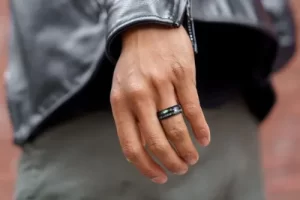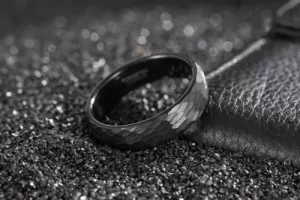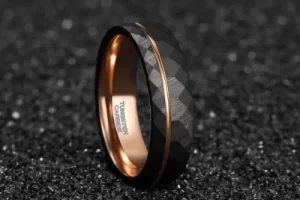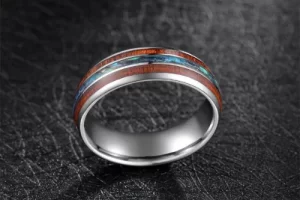The quest to uncover jewelry’s strongest sentinel draws mythic battlers into the ring – mighty tungsten versus iconic titanium clash to flaunt durability dominance. Both metals boast diehard fans and impressive strengths across sought-after areas like scratch resistance, hypoallergenic properties and corrosion protection.
But minute differences separate the two when scrutinized side-by-side. Tungsten ultimately triumphs over titanium regarding extreme resilience against daily wearing threats. However, lightweight titanium still shines where comfort and versatile styling take priority. Understanding strengths of each guides shoppers to their perfect metal match.
Let’s closely examine how these metallic marvels compare on critical counting stats to uncover the ideal metal hero for specific needs. In this battle of old guard versus newcomer, there emerges no singular winner – only metals fulfilling unique priorities beautifully.

Malleability: Titanium Leads for Flexibility
The first key metric pits Titanium’s flexible elasticity against rigid Tungsten. How suitable is each metal for bending, forming, casting and working across jewelry needs?
Titanium readily alloys mixing freely with other metals without becoming too brittle. Hot and cold titanium can smith easily into stunning shapes including ultra-thin strands and delicate lacework filigree unable to be replicated using stiff tungsten.
Tungsten conversely remains highly unreactive and non-malleable for sturdy jewelry constructions. Complex shaping needs cutting versus forging, and gem/inlay scoring requires precision drilling or computerized carving machines.
For limitless styling versatility, titanium takes the formability crown. But we’re just getting warmed up here…now onto resilience faceoffs!
Hardness: Tungsten Strength Reigns Supreme
When evaluating which metal withstands nicks and scratches better over time, Mohs mineral hardness ratings provide an excellent durability predictor. The higher score takes the toughness trophy.
- Tungsten pulls an epic 9 Mohs hardness approaching diamond tenacity. This extreme density deflects damage beautifully.
- Titanium lags significantly behind at 6 Mohs – reasonably sturdy but no fortified match for tungsten’s uncompromising strength holding daily wear at bay.
So for the uncompromising durable choice, tungsten emerges the scratch-resistant heavyweight victor thanks to its titanium transcending fortitude. But there’s more judging to be had…

Gravitas: Heavy Tungsten vs Featherlight Titanium
Factoring weight and ergonomics provides another clue between ideal metal contenders for frequent wearing across life adventures. Bulkiness burdens some.
- Fans praise Titanium’sbarely-there feel floating featherlight on fingers for comfortable 24/7 wearability. At room temperature, titanium weighs merely 60% of tungsten’s comparative density per volume.
- Tungstenconversely conveys substantial heft and a premium essence. Its small cubic volume massively outweighs delicate titanium, lending distinctive gravitas literally feeling the preciousness on hand. While initially noticeable, tungsten fans acclimate to appreciate its reassuring presence through daily feats.
So while lithe titanium lifts lightly, tungsten’s stabilizing mass captivates those seeking to feel some confident precious metal weight pressing beautifully against their skin lifelong.

Tarnish & Corrosion Resistance
We arrive at the Achilles’ heel threat facing even durable jewelry metals – oxidation & tarnish accumulation over time. Which metal withstands corroding elements best?
- Tungstenestablishes benchmark corrosion resistance thanks to its Denis packed cubic structure blocking oxygen penetration. No finish or plating coats tungsten’s inherent stability.
- Titanium depends on surface treatments like anodization or nitride coatings to bolster its adequate but less impressive natural corrosion immunity. Without protective measures, titanium falls prey to micro-scratch accumulation and gold-colored oxide formation over decades.
When it comes to battling tarnish and rust, Tungsten stands stalwart thanks to intrinsically peerless properties outshining titanium’s comparatively mediocre environmental resilience.
Additional Metal Metrics to Consider:
Final distinguishing factors complete our durability picture…
Heat Tolerance
Tungsten: Withstands over 3000°F
Titanium: Up to 1600°F
Skin Effects
Both hypoallergenic. Trace metals like nickel & copper commonly trigger sensitive skin.
Price Point
Tungsten $150+
Titanium $75-150+
Visual Styles
Tungsten: Matte to polished
Titanium: Multiple finishes
Engraving Difficulty
Tungsten: Hard, requires diamond drill bits
Titanium: Easier depth carving

The Verdict: United in Excellence Divided by Nuance
Our battle closes without a singular champion crowned. While tungsten statistically tallies more extreme durability points, titanium still forges excellence lighter and brighter across balanced areas that sway preferences.
In truth – both elevate successfully where common metal weaknesses once prevailed. They push newlimits of how incredibly far metallurgy innovations can empower jewelry longevity across the ages. Titanium and tungsten together herald a new era – the age of near invincible embellishments signifying life’s precious providence.
These distinguished metals converge as overachievers in their own top testing categories – united in advancing jewelry engineering milestones through material innovation while diverging regarding targeted specialty applications.
So rather than compete, titanium and tungsten coexist harmoniously covering more jewelry ground together as a tag team. With knowledge dispelling assumptions comes the freedom to choose your perfect metal representative based on individual priorities. Hopefully our battle served that aim!
At the end when seeking your special forever jewelry, only YOUR specific metal match reigns victorious.

